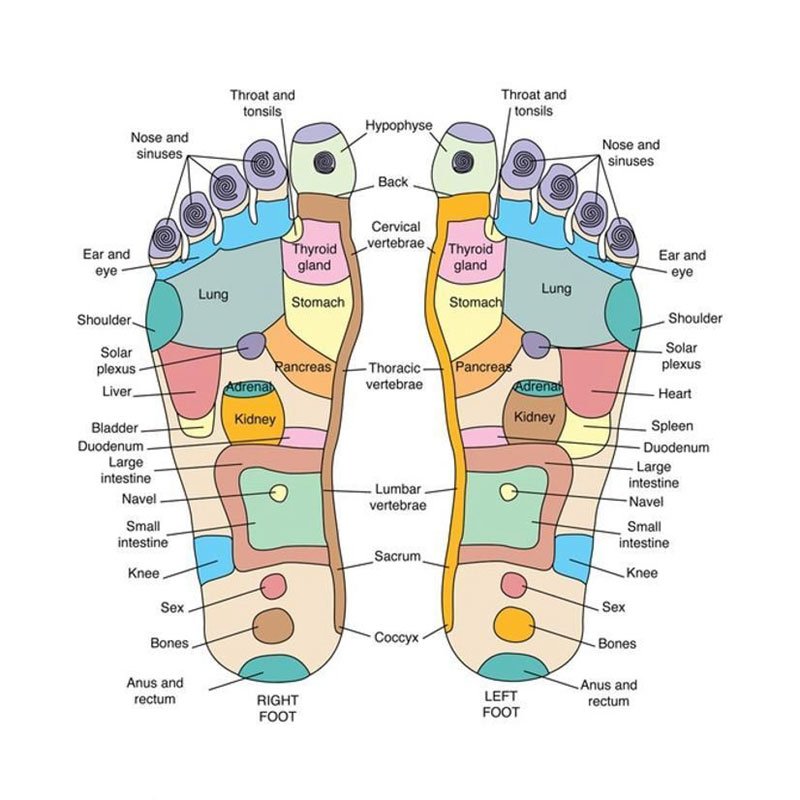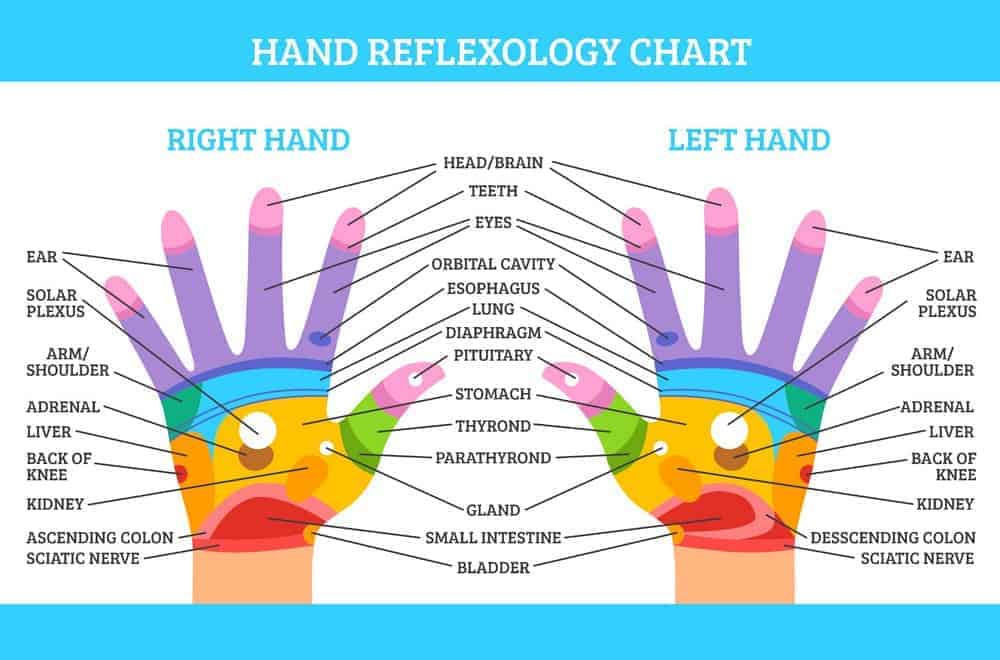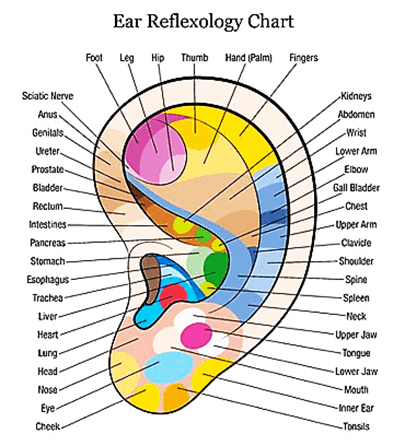According to Wikipedia, reflexology is an alternative medical practice involving the application of pressure to specific areas of the hand and feet and occasionally ears. It is done using hand, finger and hand massage techniques without the use of lotion. Its basic theory is to relieve stress and help your body work better. With a mechanism similar to acupuncture and acupressure, reflexology connects spots outside to those within and despite it being done with hands, it is not a form of massage. Reflexologists use foot charts to guide them as they apply pressure to specific areas and each pressure point acts as a sensor on the hands and feet and is linked to specific body parts. The stimulation of these sensors is done by applying reflexology techniques to improve blood and energy circulation, giving a sense of relaxation and maintaining homeostasis
Reflexology complements other treatments that a patient may be undergoing or may have undergone using reflexology maps.
History of reflexology
A Strong opinion suggests that the practice of reflexology in China, India, and Egypt about 5000 years ago.
Cryptic hieroglyphics and paintings in the caves and palaces indicate the existence of reflexology practice at those times. Written evidence of the “examining foot method” is found in the Yellow emperor’s classic of internal medicines written around 1000 BC in China.
Acupuncture therapy was practiced in china in 2500 BC, and that is believed to have a connection with the zone therapy of reflexology.
The North American Indian Tribes practiced primitive reflexology some hundreds of years ago.
Reflexology entered Europe when Marco Polo translated a Chinese massage book into Italian in 1300 AD.
Though it did not evince great interest, books on Zone Therapy were published in Europe in 1582. Dr. Adams and Dr. A Tatis had independently written on Zone therapy.
Mr. James A Garfield was the president of the USA in 1881, and he adopted reflexology to relieve pain.
Dr. William H FitzGerald is considered to the father of Modern Zone Therapy. He revived ancient therapeutic knowledge and skill. Some believe that Dr. William FitzGerald, on his own, developed zone therapy during his course as a medical practitioner and that it had no connection with the developments in Europe and Asia.
In the year 1917, Dr. William H FitzGerald published a book on Zone therapy. The idea of Zonal Analgesia came into being. The complete human body was divided into ten vertical zones, five on each side.
These vertical zones were mapped in the soles of the human feet with five zones marked in each sole. All the body parts are representatively located in one of these vertical zones.
Dr. Joe Shelby Riley assisted Dr. William in Zone Therapy, and in due course of time, he added eight horizontal rows to the ten vertical zones.
This continued interest and research in Zone therapy kept it alive. Dr. Eunice Ingram is considered the pioneer of Modern Reflexology.
She used to work with Dr.Joe Shelby Riley and took the good work ahead. She is credited with developing the foot maps and reflexology maps as it exists today.
In the year 1950, Dr. Paul Nogier identified the reflexology points in the ear.
Methods and Techniques of reflexology
There are two main methods of reflexology that are internationally accepted: The ingham method and the rwo shur method.
The mechanism of the first method is done without the use of tools whereas the second method is very tool inclusive e.g wooden sticks.
There are five theories that explain how reflexology actually has an impact on health. The first and second basic theories are related to energy. Energy theory advocates that body parts can communicate using electromagnetic fields, and communication can be blocked based on the surrounding fields.
The third theory indicates that energy flow can be restored, the fourth theory is about a blocked pathway that can be opened. And the last theory proposes that reflexology can break up the lactic acid crystals that are usually deposited in the feet and allow energy to flow efficiently.
Modern reflexology techniques have been used for the last 60 years and now more scientific and clinical research has been conducted because of its positive effects in reducing and alleviating symptoms, especially those associated with chronic conditions such as diabetes mellitus, hypertension and muscular diseases. Reflexology generally does not cause any harmful effects as long as necessary precautions are taken with patients with special medical conditions such as blood clot disorder, cancer and heart failure.
Each person has a different body system so results from reflexology treatment could vary from one person to another. Based on the latest research conducted, reflexology seems to be effective in helping body systems return to their natural state. One of the most significant current discussions in reflexology is its effectiveness in helping to tackle several symptoms of the disease. The level of disease conditions and pain are reduced as the patients receive reflexology. It has been suggested by a Swiss study that patients having reflexology sessions show a significant decrease in the amount of medication they require. As a complementary therapy, reflexology seems to work better together with conventional treatment to treat chronic diseases that alter the normal physiological functions of the body.
One of the most significant current discussions in reflexology practice is around aspects of health, safety and hygiene. Other than that, the principles and practice of reflexology as a complementary therapy are important to ensure the application of this therapy is reliable.
What are reflexology points and areas?
According to reflexology theory, points and areas on the feet, hands, and ears correspond to specific organs, bones and body systems. Practitioners access these points on the feet and hands (bottom, sides, and top) and the ear (both inside as far as the finger can reach and outside) to affect organs and systems throughout the entire body.
To represent how the body systems correspond to one another, reflexologists use reflexology “maps.” Understandably, there is no agreement among all reflexologists on all points; however, general agreement does exist on major reflex points.
A reflexologist may perform a general, integrated session, or may focus on specific problem areas on the feet, hands or ears. For example, if time is limited and the person really needs to relax, the reflexologist may choose just to work on the ears.
Whatever the specific technique, reflexology theory holds that the practitioner is working to release congestion or stress in the nervous system and balance the body’s energy.

As can be seen in the foot chart, all body parts are located on the soles. The parts on the right side of the body are on the right sole, and the left ones are on the left sole. Few body parts like stomach, intestines, etc. are on both the soles
Both the soles put together to represent the whole body with internal organs.
The location of various organs is shown in the chart. The stimulation point is left to the judgment and experience of the therapist. There are various opinions on the exact point locations.
For instance, to treat the problem of sciatica, the edge of the heel is stimulated or massaged. The sciatic nerve is represented in this part of the sole.
Similarly, for different problems, first, locate where the affected organ is represented on the sole. Then stimulate or massage the points.
Generally, fingers and thumbs are used for stimulation. Massage is done by the hand. However, of late, some manual and electrical tools and devices are available to do the needful.

Just as in the foot chart, the hand chart also represents several body organs in the right and left palm. Interestingly, the back of the palm also carries some reflexology points.
Between the foot and hand chart, the foot chart carries more points and is more detailed.

Reflexology points are also located on the outer and inner ear lobes. The ear points are generally used when a quick refreshing therapy is desired.
For pain relief and treatment, the foot and hand points are stimulated. However, since it is not an exact science, a lot depends on the therapist and his style.
Benefits of reflexology massage
1. Pain Relief
A reflexology massage feels wonderful on your hands, feet and face, effectively knocking out anxiety and reducing pain in these extremities. Regardless, thanks to the pathways connecting them to the rest of your body, a reflexology massage soothes myriad muscle groups and has even been indicated to improve pain and postpartum recovery, correlated with pregnancy.
2. Stimulates the nervous system
like most parts of the body, nerve endings begin to deteriorate with age. A reflexology massage boosts your nerve pathways, strengthening nerve function to over 7,000 nerve endings throughout the body – simply by stimulating the right points in your hands, feet, ears, or face!
3. Increases Circulation
As far as your heart is concerned, your hands and feet indicate the farthest reaches of your body. Stimulating these extremities with reflexology promotes circulation, and as a result, delivers more oxygen-rich blood to all parts of your body. Vital organ systems regulate retorts more efficiently, so it should come as no surprise that this is one of the most influential and major benefits of reflexology.
4. Boosts Metabolism
With increased circulation and metabolism function, your body begins to fire on all cylinders, which is why a reflexology massage can really improve your metabolism. As amazing as it sounds, a proper hand or foot massage can lead to a boost in energy, and make losing weight easier!
5. Eliminates Toxins
Reflexology connects your arms, legs, ears, and face with important internal organs, and one of these is your bladder. A reflexology massage can be very effective in increasing bladder function, which makes your body more productive for eliminating toxins. Studies even show reflexology helps people recover from urinary tract infections.
6. Speeds Up the Healing Process
Another positive result of the combined boost to circulation, metabolism, and the central nervous system is that the body has more powerful resources to heal itself. For someone recovering from injury or surgery, a reflexology massage can help relieve pain and speed up the time it takes to return to your routine.
7. Comfort
Just because circulation and metabolism are stimulated doesn’t mean your body can’t rest deeply, either. There is a big difference between a relaxed, active state and a stressed, excited state. Like most massages, reflexology relaxes the body, but it also reduces the tension that can turn your energy against you.
8. Relieves Sleep Disorders
The relaxation you feel after a reflexology massage can benefit all the way to your bedroom. The link between insomnia and stress can be hard to conquer, but a reflexology massage enables you to physically conquer a significant obstacle in your natural sleep cycle.
9. Reduces depression
There are many factors associated with depression, many of which are related to stress and body chemistry. Since reflexology helps to eliminate stress and improve the efficiency of your nervous and circulatory systems, it can help maintain the balance of your hormone levels, reducing the likelihood of a depressive episode is like.
10. Reduces Headaches
Millions of people suffer from regular migraine and tension headaches, and they can all benefit from reflexology massage. Whether a headache is caused by a chemical imbalance, stress, or muscle tension, the healing properties of reflexology can treat a headache in the process, and prevent the next one.
Contraindications of reflexology
Although reflexology is mainly for the healing process, it is very necessary to be familiar with a few contraindications or times when reflexology might not be a wise choice. These contraindications are as follows:
Foot injuries
Patients with foot fractures, unhealed wounds, or active gout in the foot. All patients with this should stay clear from reflexology. Patients with osteoarthritis that affects the foot or ankle, or the ones with vascular disease of the legs or feet, should discuss with their immediate provider before the beginning of reflexology on the feet. You can, nevertheless, still get reflexology treatment on your hands and ears.
Pregnancy
For women in early pregnancy, the ones in the first 6 weeks, the reflexology massage session is distorted by doctoring the uterine and ovarian reflex points very gently or by voiding them all together. Generally speaking, wariness should be practiced during pregnancy because of reports that stimulation may cause contractions.
Blood clotting issues
Some patients will recount existing thrombosis or embolism that is; obstruction of the pulmonary artery or a branch of the pulmonary artery by a free-floating blood clot or embolism, and should not undergo reflexology therapy. The fact that reflexology increases circulation, could also result in a clot moving toward the heart or brain.
Open wounds
Generally speaking, medical practitioners will stay off open wounds and may decide to wear plastic gloves or decide not to treat areas that are endangered.
Is it safe to try reflexology?
Generally, reflexology is very safe, even for people living with serious health conditions. It’s non-invasive and comfortable to receive, so it may be worth trying if it’s something you’re interested in.
However, you should talk to your doctor first if you have any of the following health issues:
- circulatory problems in the feet
- blood clots or inflammation of your leg veins
- gout
- foot ulcers
- fungal infections, like athlete’s foot
- open wounds on your hands or feet
- thyroid problems
- epilepsy
- a low platelet count or other blood problems, which can make you bruise and bleed more easily
You may still be able to try reflexology if you have any of these issues, but you might need to take a few precautions to avoid any adverse effects.
Some people also report having mild side effects after a reflexology treatment, including:
- light-headedness
- tender feet
- emotional sensitivity
But these are short-term side effects that tend to go away shortly after treatment.
The key difference between reflexology and massage
It is important to note that reflexology and massage are two different techniques although they share certain similarities. Firstly, reflexology involves the application of pressure to certain pressure points on the body (in most cases hands and foot) in order to improve general health while massage involves manipulating tissues of the body in order to ease stress and to facilitate relaxation. Also, reflexology uses only the hands of the practitioner during the session but in massage, tools like balls, rollers, massage tables, chairs, essential oils etc. It is expected that during a massage session, the patient puts on only underwear. However, in the case of reflexology, the patient is fully clothed because the therapist touches only the handstand feet and in some cases, the ears.
Conclusion
Reflexology may not be a scientifically proven medical treatment for the disease, but studies suggest it’s a helpful complementary treatment, especially for stress and anxiety. It is important to talk to your doctor if you have any serious existing conditions before seeking treatment.





Great post.